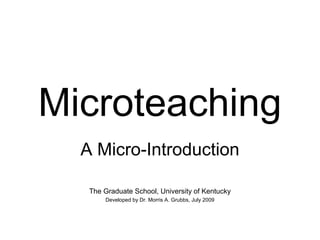
Microteaching introduction with example of lesson plan
- 1. Microteaching A Micro-Introduction The Graduate School, University of Kentucky Developed by Dr. Morris A. Grubbs, July 2009
- 2. What is Microteaching? A training concept that originated in the Stanford Teacher Education Program in the 1960s A teaching-simulation exercise that will provide you with immediate supportive feedback A set of best practices for you to follow (or at least consider) when teaching your students An opportunity to practice skills useful beyond the classroom (e.g., presenting at a conference, job interviewing, speaking with the public about your research) An orientation component consistently rated beneficial
- 3. A Learner-Centered Experience Microteaching is a way for you to hone your skills in a supportive peer-learning environment. You will see that your peers share with you many of the same struggles, the same weaknesses, the same strengths. You will recall techniques or learn new ones by observing your peers.
- 4. Choosing a Mini-Lesson Topic Your topic should be relevant to your discipline narrow and small-scale aimed at first-year college students a lesson you might teach early in the semester appropriate for interactive learning
- 5. What Does Not Work Well as a Topic? A section from your thesis A paper you’ve written for a conference A subject more appropriate for your peers in graduate school A lesson that requires multiple technical terms and jargon A topic that is too broad to cover effectively within the scope of eight to ten minutes
- 6. A Sample Mini-Lesson Learning Context: An entry-level writing course; a unit on effective punctuation in standard English prose Lesson Topic: Conventional usages of the colon Learning Goal: By the end of the lesson, students will be able to recognize and employ two conventional usages of the colon
- 7. Sample Lesson Plan Outline I. Opening (2 minutes) Ask students to take a minute to jot down a brief sentence illustrating a common use of the colon. Quickly write one of your own examples on the board illustrating an explanatory relationship between complete thoughts (as in the example below). Ask students to consider if their examples match yours in the way the colon is used (most of theirs will likely illustrate a colon signaling a list). Ask a volunteer to explain the relationship between the two thoughts in the sentence on the board. Suggest why this lesson could be useful: a colon can signal a meaningful connection between complete thoughts and thus facilitate quick reading comprehension. Example: This film has been modified from its original version: it has been formatted to fit your television screen. (Note that the motion picture industry often punctuates these thoughts as two separate sentences. Which version might be stronger and why?)
- 8. II. Body (5-7 minutes) Ask a student to volunteer an example of a colon signaling a list, perhaps one that he/she jotted down earlier. Write it on the board. Assess whether it uses the colon conventionally (or “correctly” according to “rule books”) and explain why. Some types that might be offered: A. The items I enjoyed the most at the restaurant were: grilled salmon, jasmine rice, asparagus, and bourbon pie. (point out that no colon is needed here and explain why) B. Alfredo sauce consists of: butter, parmesan cheese, heavy cream, and black pepper. (again, no colon is needed) C. The restaurant offers three low-fat side dishes: steamed broccoli, roasted zucchini, and long-grain rice. (good use of colon because it comes at the end of a complete thought and signals that what follows are the items; point out alternative phrasing without colon: e.g., For its low-fat side dishes, the restaurant offers steamed broccoli, roasted zucchini, and long-grain rice.) If time allows, revise a pair of linked independent thoughts to show alternative punctuation and connector words; briefly discuss colon usages relevant to genre and audience.
- 9. III. Closing (1-2 minutes) Draw to a close by reasserting the two conventional colon usages your students have learned: 1. Use a colon after a complete thought to signal an explanation or exemplification or cause. 2. Use a colon after a complete thought to introduce a list. End with a little humor by writing the following sentence (from Lynne Truss’s Eats, Shoots & Leaves) on the board, which will also serve to introduce the next unit on semicolons: I pulled out all the stops with Kerry-Anne: I used a semicolon.
- 10. III. Closing (1-2 minutes) Draw to a close by reasserting the two conventional colon usages your students have learned: 1. Use a colon after a complete thought to signal an explanation or exemplification or cause. 2. Use a colon after a complete thought to introduce a list. End with a little humor by writing the following sentence (from Lynne Truss’s Eats, Shoots & Leaves) on the board, which will also serve to introduce the next unit on semicolons: I pulled out all the stops with Kerry-Anne: I used a semicolon.
